Preprint
Article
Surfactant-polymer Flooding: Chemical-formula Design and Evaluation for High-temperature High-salinity Qinghai Gasi Reservoir
Altmetrics
Downloads
92
Views
26
Comments
0
A peer-reviewed article of this preprint also exists.
This version is not peer-reviewed
Submitted:
06 April 2024
Posted:
08 April 2024
You are already at the latest version
Alerts
Abstract
Chemical flooding methods are used to recover the remaining oil after water flooding, and surfactant-polymer (SP) flooding is an important chemical flooding technology. It is of great significance to design and screen high-performance oil displacement agents in order to overcome the increasingly challenging high temperature (>70 ℃) and high salinity (>10,000 mg/L) reservoirs. Based on the characteristics of high temperature (70 ℃) and high salinity (151,000 mg/L) in the Qinghai Gasi reservoir, the performance of the SP flooding system was studied. This study considered interfacial tension, emulsification, viscosity, compatibility, and oil displacement efficiency. The selected formula demonstrated high resistance to both salinity (151,000 mg/L) and temperature (70 ℃), characterized by a low oil-water interfacial tension (10-2 mN/m) and high viscosity (18.13 mPa.s). After water flooding achieved an oil recovery rate of 64.64%, the subsequent replacement rate of crude oil increased by 26.95%, confirming that SP flooding can be used as a technology for enhancing oil recovery in high-temperature, high-salinity reservoirs represented by Qinghai Gasi reservoirs.
Keywords:
Subject: Engineering - Energy and Fuel Technology
1. Introduction
Surfactant/polymer (SP) flooding system, as an effective technique for enhancing oil recovery (EOR) in high-water-cut oilfields, has been successfully applied in conventional low-temperature, low salinity sandstone reservoirs in China.[1,2] Currently, this technique has been considered to apply to more challenging oilfields, such as high-temperature and high-salinity reservoirs.[3,4,5]
The Qinghai Gasi reservoir belongs to the sedimentary facies of discernible river deltas, with sandstone, siltstone, and conglomerate as the main rock types. Sandstone and siltstone normally show better oil-bearing properties. The reservoir's storage space is mainly composed of primary pores in sandstones and conglomerates followed by mixed pores, and a small number of secondary pores. The average reservoir depth is 1771 m, and the original formation pressure is 11.90 MPa. The average temperature is 66.5°C, the highest temperature is 78°C, and the total salinity of formation water ranges from 151,000 to 170,000 mg/L.[6] Given that the Gasi reservoir is typical high-temperature and high-salinity reservoir, improvements must be made for chemical flooding agents to endure the challenging temperature and salinity. Since 1990, the Gasi reservoir has been subject to water flooding development. However, after more than 30 years of water injection, the reservoir has entered a mid-to-high water cut development stage, with a comprehensive water cut of 76% and a recovery factor of 47%[7]. These figures illustrate that water flooding alone is no longer sufficient to meet the development needs as the reservoir matures. Consequently, to address these challenges, the adoption of SP chemical flooding EOR technology has been proposed.
For high salinity saltwater, available petroleum sulfonate surfactants are easily affected by divalent ions to form precipitates, and high TDS levels can also trigger phase separation phenomena[8]. The high salinity of water requires the selected surfactant to have stronger water affinity . In order to maintain a balanced affinity to oil and water, surfactants with stronger hydrophilic head groups require longer hydrophobic tail chains. Extended surfactants have been introduced to address this.[4,9].
Extended surfactants are characterized by the inclusion of intermediate polarity groups, such as propylene oxide (PO) or ethylene oxide (EO), situated between the hydrocarbon tail and the hydrophilic head group. This distinct molecular architecture allows the surfactant molecules to extend more effectively into both oil and water phases, enhancing their interfacial activity. Specifically, surfactants featuring alkoxy chains, namely EO and/or PO, demonstrate improved tolerance to environments with high salinity, as many several laboratory studies and pilot tests have proved[10,11,12]. This study focuses on the selection of extended surfactants as its primary research subject, with the objective of enhancing surfactant efficacy in oil reservoir conditions characterized by high temperatures and elevated salinities.
Conventional polymers, such as partially hydrolyzed polyacrylamide (HPAM) undergo self-hydrolysis or breakage in high-temperature and high-salinity conditions[13]. The presence of divalent cations further accelerates this decomposition. [14]. Therefore, proper molecular design should be taken to enhance high-temperature and high-salinity tolerance and minimize the negative effects of divalent cations.
In recent years, polymer research has focused on increasing the viscosity of polymer solutions, primarily achieved by increasing the molecular weight of the polymers.[15,16] A higher molecular weight contributes to a larger hydrodynamic volume of polymer molecules, which elevates the viscosity of polymer solutions. However, in low-permeability reservoirs of some oilfields, the high-molecular-weight polymers cause reservoir plugging due to their lower permeability. However, in oilfield practices, high molecular weight polymers may lead to reservoir blockage, making it difficult to inject polymer solutions. To address this, polymers designed for flooding must satisfy two requirments: (1) they should have a lower molecular weight (2) they should be capable of attaining the necessary viscosity at lower concentrations, under the premise of using produced water for the preparation of polymer solutions. The development of such polymers represents a significant and urgent challenge in the field.
To prepare polymers with both good thickening ability and excellent temperature and salt resistance, current research predominantly utilizes acrylamide as the foundational monomer[17].Following this approach, when synthesizing new temperature and salt-resistant polymers, acrylamide is used as the base monomer. Carboxyl groups in HPAM are replaced with strongly hydratable anionic groups that do not form precipitates with divalent ions. Additionally, large-volume side groups are introduced to increase the rigidity of large polymer chains, suppressing the drastic reduction in the size of polymer aggregates caused by the participation of inorganic electrolytes. Anionic hydrous groups are introduced into the polymer chain using highly active monomers containing sulfonic acid groups, and large-volume side groups are introduced into the large polymer chain using compounds containing benzene rings. Thus, temperature and salt-resistant polymers are constructed as acrylamide-based copolymers containing benzene rings and sulfonic acid groups.
This paper conducts a feasibility study on the chemical compound flooding (SP) for the Qinghai Gasi oil reservoir. Through experiments such as screening tests of chemical compound flooding formulas and core displacement tests, the effectiveness of chemical flooding methods to improve oil recovery in high-temperature and high-salinity reservoirs is explored. This study lays the foundation for future pilot tests of chemical compound flooding in complex high-temperature and high-salinity oil reservoirs.
2. Materials and Methods
2.1. Materials
Polymer Samples
The polymers used in the study include conventional polyacrylamide HPAM-21 (average molecular weight of 21 million), high-temperature and high-salinity resistant polymer BRH-325 (average molecular weight of 20 million), and existing conventional salt-resistant polymers SNF AN-132 and SNF SAV-55.
Surfactant Samples
Surfactants were selected from different types for screening low interfacial tension (IFT) formula tests, polyether extended surfactants: A3, B2 and B3. Petroleum sulfonate ZC-2, which was kindly provided by Qinghai oilfield.
Oil Samples
The crude oil sample was taken from the Gasi oil reservoir, with a density of 0.825 g/cm3. The viscosity of crude oil is 6.5 mPa·s.
Rocket Samples
The artificial cores were produced to replicate the permeability and porosity characteristics of the Gasi reservoir. The measured dimensions and properties of these cores are as follows:
Table 1.
core characteristic.
| number | Length(cm) | Diameter(cm) | Porosity(%) | Permeability(mD) |
|---|---|---|---|---|
| 1 | 9.899 | 2.495 | 26.116 | 100.0 |
| 2 | 9.980 | 2.504 | 27.373 | 100.0 |
Brines
The water used in this study is simulated formation water based on the produced water from the Gasi Reservoir. Salinities: 152144mg/L. The content of divalent ions is salinities: 7149mg/L
2.2. Experimental Methods
Viscosity Test
The viscosity of the polymer was measured using a DV-2T Brookfield digital viscometer, operating at a rotational speed of 6 rpm, The experimental temperature was set at 70°C to simulate the reservoir temperature of Gasi oilfield. Initially, the selected polymer was added to the simulated formation water in predetermined ratios. This mixture was then stirred using a paddle stirrer at 400 rpm for 2 hours, mirroring the onsite polymer solution preparation process. Subsequently, the solution was heated to 70℃. Once the temperature was stabilized for 15 minutes, the samples were subjected to viscosity measurement.
Interfacial Tension Test
The interfacial tension between the surfactant solution and crude oil was measured utilizing a rotating drop interfacial tensiometer (Model CNG701, Shengwei, Beijing). Crude oil drops were then introduced into the surfactant-containing sample tube using a micro syringe. This prepared tube was placed into the interfacial tensiometer for analysis. The instrument's rotational speed was maintained at 5000 rpm, and measurements were recorded following a stabilization period of 2 hours
Emulsion Stability Test
In this experiment, 4 ml of n-alkanes were combined with 4 ml of an aqueous surfactant solution (0.3 wt%) in a small glass vial. The mixture was then homogenized for 30 seconds at a speed of 13,000 r/min using a homogenizer. Subsequently, the homogenized mixture was transferred into a 10 ml slender graduated tube. The volume of each phase was recorded constantly over a ten-day period.
For the purpose of evaluation, the emulsification stability was characterized by oil separation rate:[18]
- oil separation rate,%;- Initial volume of oil,ml;- Volume of emulsified oil,ml.
Core Flooding Test
Based on the analytical method of alkali-surfactant-polymer flooding system (Chinese standard SY/T 6424-2014)[19], core flooding experiments of SP chemical flooding system were conducted, encompassing a sequence of defined steps:
Core saturation with water: the core was dried, and saturated with simulated formation water, and pore volume was determined by gravimetric method at room temperature and pressure.
Core saturation with oil: the core was driven with crude oil/simulated oil at an injection rate of 0.1mL/min to establish bound saturated oil, and driven at room temperature until the oil content of the fluid was more than 98%, and then the core was placed at reservoir temperature for 48h.
Water flooding: At reservoir temperature (70℃), use simulated formation water to displace the core at an injection rate of 0.1mL/min, simulate water-driven oil to more than 98% water content, record the injection pumping pressure, peripheral pressure and back pressure, volume of water-driven oil and oil volume of produced fluid
Subsequent Waterflooding: subsequent water drive, reservoir temperature (70℃), with simulated formation water at an injection rate of 0.1mL/min to drive the core, simulated water drive, until the water content of the recovered fluid is more than 98%, record the relevant data
The temperature of the core displacement experiment was maintained at 70℃, with an injection rate of 0.1 ml/min and a background pressure of 15 MPa. During the experiment, pressure differentials, oil production, water production, and total fluid production were promptly recorded to accurately calculate the incremental oil production and water cut of chemical flooding.
3. Results and Discussion
3.1. Polymer Selection
Viscosity Test
According to our understanding, this study selected and utilized several polymers for screening, including conventional partially hydrolyzed polyacrylamide HPAM-21, salt-resistant polymer BRH-325, SNF AN-132, and SNF SAV-55. All polymers were prepared with simulated formation water, and viscosity measurements were conducted at reservoir temperatures.
The curve depicts the variation of polymer viscosity with concentration in Figure 1. The viscosity of the polymer was directly proportional to its concentration. At same concentrations, BRH-325 exhibits higher thickening ability compared to other products. Therefore, this polymer has been selected as a candidate material for chemical composite flooding. Typically, the viscosity of the SP chemical flooding solution should be 2-4 times higher than that of the crude oil. Consequently, a concentration of 2000 mg/L of polymer solution has been chosen as the formula for screening.
Thermal Stability
In oilfield development, SP chemical flooding need to remain operational for several months or even years, exerting a continuous impact on the reservoir. Polymers, as an integral major component of these agents, often struggle fail to maintain their viscosity characteristics over extended periods time, particularly under high-temperature, high-salinity conditions. Therefore, long-term stability tests were designed to verify whether polymers can sustain stable viscosity properties over time. The experimental results showed that the viscosity of BRH325 was 58% higher than that of HPAM, and its viscosity retention rate exceeded 80% in a 90-day long-term stability test, while the HPAM only retained 35.6% viscosity.
Figure 2.
The variation of viscosity of different polymers over time.
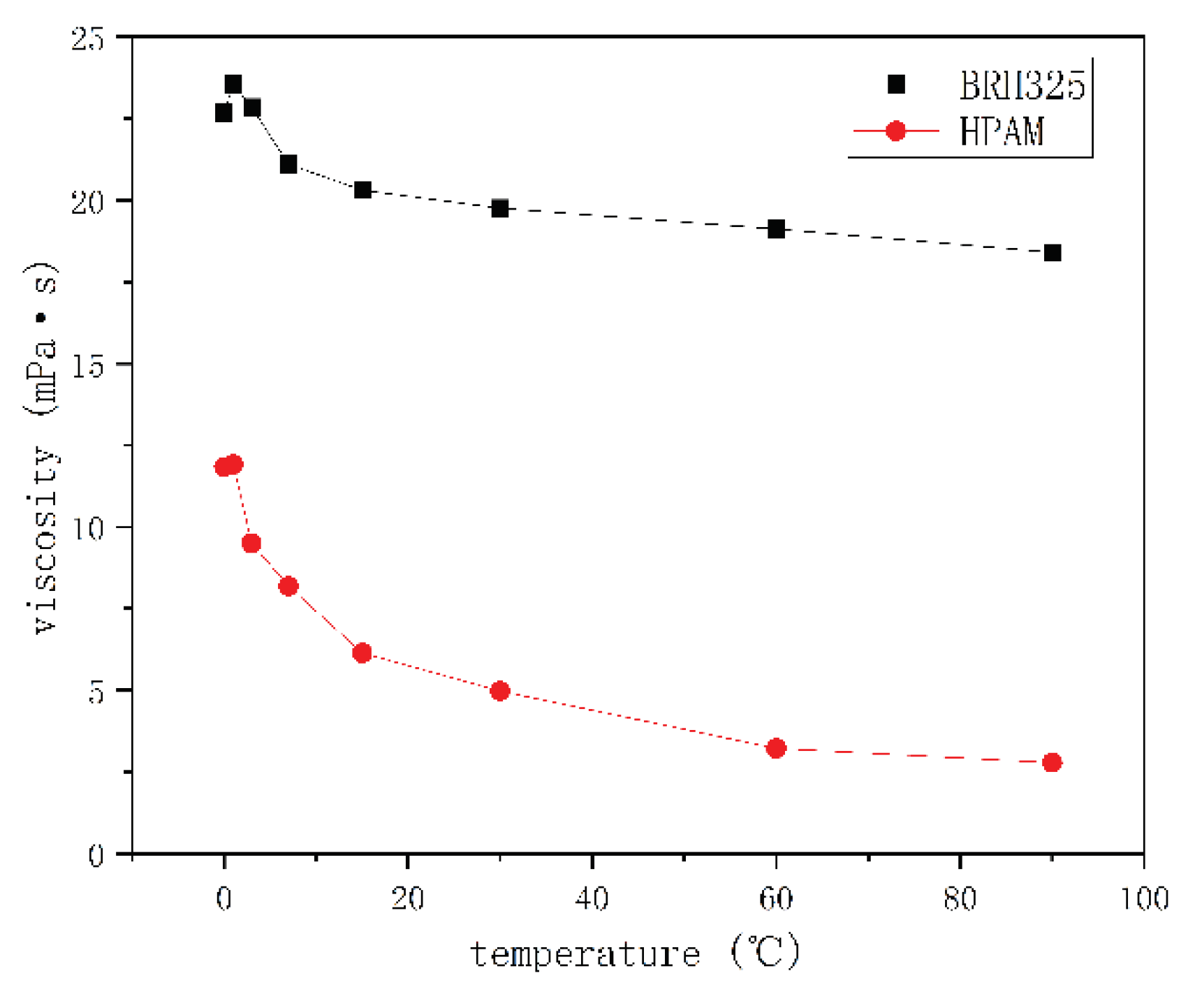
3.2. Surfactant Selection
Interfacial Tension Test
This study selected various types of surfactants and evaluated the interfacial tension between surfactant solutions and crude oil. The concentration of surfactants was controlled at 0.3%, petroleum sulfonate ZC-2, polyether extended surfactants B2, B3, and A3. Additionally, there were combinations of two surfactants forming GSS-A, GSS-B, and GSS-C. The results are shown in the Figure 3.
The results demonstrate that the surfactant combinations exhibit superior interfacial properties, reaching the magnitude of 10-2mN/m within the temperature range of 60-90°C. This indicates the synergistic effect between spreading surfactants and anionic surfactants. Based on its interfacial activity at high temperatures, we determined GSS-A as the formula for subsequent research.
We selected the existing surfactant ZC-2 and the improved surfactant GSS-A as the subjects of our study. In order to gain a more comprehensive understanding of their performance across a wider range of temperatures and concentrations, and to meet the temperature requirements (130°C) of the deep reservoirs that might be developed in the future, we conducted detailed scanning experiments. The experimental results are presented in the Figure 4.
The experimental finding showed, for ZC-2, the ability to maintain an interfacial tension of 10-2mN/m is confined to a temperature range of below 70℃, at concentrations ranging from 0.05% to 0.3%. In contrast, GSS-A exhibits a temperature tolerance, maintaining the same interfacial tension from 60℃ to 120℃, within the same concentration parameters. Such a surfactant formula significantly broadens the operational window of temperature and concentration, enhancing its applicability across a wider spectrum of scenarios. This expanded operational window not only facilitates a wider range of application scenarios but also holds promise for improving the efficiency and practicality of actual oil recovery operations.
Emulsion Stability Test
In addition to reducing interfacial tension, emulsification is also a crucial mechanism in the oil recovery process. Through effective emulsification, emulsifiers can mix the oil and water phases to form stable emulsions, making it easier to extract crude oil. To fully understand the emulsification performance of surfactants before and after improvement, a series of experiments were designed and conducted. The experimental results are presented in the Figure 5.
The quantitative analysis illustrated in the Figure 5, which tracks the volume change of the emulsion over time, serves as an indicator of the emulsifying performance of various surfactants. In the system utilizing ZC-2, the oil separation rate reaches 100%, indicating a rapid disintegration of the emulsion post-formation. This showed that the ZC-2 system fails to establish a stable emulsion structure, likely due to ZC-2's inherent limited emulsifying capabilities. Conversely, the GSS-A surfactant demonstrates a superior emulsifying performance, forming a emulsion in the formulation with an initial oil separation rate of 1.4% on day 0, which gradually increases to 30.99% by day 10. These results highlight the GSS-A surfactant's robust emulsifying properties, enabling effective blending of the oil and water phases and maintaining the emulsion's structural stability over time.
Figure 6 shows the effect of different surfactant concentration on the emulsification performance of the system, it can be seen that ZC-2 surfactant in the full concentration range of the oil separation rate is close to 100%, after the compounding of the surfactant system in the concentration of 0.2% can be in the ten days to have a solubilized oil rate of 40.83%, in the concentration of 0.3% in the oil separation rate in 30%.
Figure 7 shows the oil separation rates after 10 days under different salinity concentrations. At lower salt concentrations, both the ZC-2 and the composite surfactant systems exhibit relatively minimal oil separation rates, each registering below 10%. Notably, as salinity escalates to 15%, a marked difference in performance emerges: the oil separation rate for ZC-2 surges to 93%, whereas the GSS-A maintains a significantly lower rate of 8%. This juncture, corresponding to the 15% salinity level, is particularly relevant to the conditions prevalent in the Qinghai oilfield. Under such high salinity circumstances, the GSS-A demonstrates superior emulsification efficacy compared to the ZC-2 surfactant, underscoring the GSS-A's enhanced performance and potential applicability in environments with elevated salt concentrations."
3.3. Polymer-Surfactant Compatibility Test
In reservoir development, careful consideration of the compatibility between polymers and surfactants is crucial when designing polymer-surfactant binary oil recovery formulas. Surfactants may affect the viscosity of polymers, while the addition of polymers can also impact the interfacial properties of surfactants, potentially reducing the efficiency of Enhanced Oil Recovery (EOR) processes. Therefore, in formula design, it is imperative to select polymer-surfactant combinations that are mutually compatible and exhibit good stability to ensure that the final EOR agent does not incur performance losses, thus achieving the desired outcomes in reservoir development. To address this, compatibility experiments were designed, with Figure 8 depicting interfacial tension testing of surfactants and binary formulas, and Figure 9 illustrating viscosity testing of polymers and binary formulas.
The experimental findings reveal that within the temperature range of 50-80 ℃, the interfacial tension achieved by the SP formula is lower than that observed with the use of the GSS-A surfactant alone. Additionally, the viscosity of the SP formula surpasses that of the BRH325 polymer. This observation proved the excellent compatibility between surfactants and polymers, laying a solid groundwork for their integration in future formulation endeavors. Such compatibility is indicative of the potential for developing more effective and efficient SP flooding formula.
3.4. Core Flooding Test
To assess the efficacy of the SP flooding formula, core oil displacement experiments were conducted. The dynamic oil recovery curves, presented in Figure 10 and Figure 11, compare the performance of the ZC-2 with that of the SP formula in the oilfield context. The experimental outcomes showed that the ZC-2 had an 8.4% increase in recovery rate. In contrast, the SP oil displacement formula enhanced the recovery rate by 26.95%, thereby confirming its superior oil displacement capabilities. The pronounced heterogeneity of sandstone reservoirs underscores the advantage of binary composite flooding, which augments both displacement efficiency and sweep efficiency, over single surfactant systems that primarily enhance oil recovery efficiency. Consequently, SP flooding has demonstrated a markedly improved performance in boosting oil recovery compared to single surfactant flooding.
4. Conclusions
The formula GSS-A, a mixture of extended surfactants and petroleum sulfonates, was selected as the surfactant component in the SP formula. GSS-A enhanced its interfacial and emulsification performance under high-temperature and high-salinity conditions. It also expended the range of temperature, salinity, and concentration for its application. The interfacial tension could be maintained at the level of 10-2 mN/m under conditions of 151,000 mg/L and 60-130°C. The salt resistant polymer BRH-325 was selected as the candidate polymer for the formula/formula. Its viscosity is 58% higher than conventional polymers. Furthermore, it has a viscosity retention rate exceeding 80% in a 90-day thermal stability test. The compatibility of selected polymer and surfactant has been discovered through experimentation, simultaneously enhancing interfacial performance and viscosity. Core flooding experiments were conducted based on the specific conditions in the Qinghai Gasi reservoir. The results showed that the examined SP flooding formula could increase the oil recovery rate by 26.95%. It has been confirmed that SP flooding can be used as a enhance oil recovery technology in high-temperature, high-salinity reservoirs represented by Qinghai Gasi reservoirs.
References
- Sun, C.; Guo, H.; Li, Y.; Song, K. Recent Advances of Surfactant-Polymer (SP) Flooding Enhanced Oil Recovery Field Tests in China. Geofluids 2020, 2020, 1–16. [Google Scholar] [CrossRef]
- Zhu, Y.; Liu, X.; Fan, J. Developments of ASP/SP flooding formulations for Huabei fault block reservoir. In Proceedings of the SPE/IATMI Asia Pacific Oil & Gas Conference and Exhibition, 2015; pp. SPE-176117-MS. [Google Scholar]
- Barnes, J.R.; Smit, J.P.; Smit, J.R.; Shpakoff, P.G.; Raney, K.H.; Puerto, M.C. Development of surfactants for chemical flooding at difficult reservoir conditions. In Proceedings of the SPE Improved Oil Recovery Conference, 2008; pp. SPE-113313-MS.
- Huang, L.; Lips, A.; Co, C.C. Microemulsification of Triglyceride Sebum and the Role of Interfacial Structure on Bicontinuous Phase Behavior. Langmuir 2004, 20, 3559–3563. [Google Scholar] [CrossRef] [PubMed]
- Liu, S.; Zhang, D.L.; Yan, W.; Puerto, M.; Hirasaki, G.J.; Miller, C.A. Favorable Attributes of Alkaline-Surfactant-Polymer Flooding. SPE J. 2008, 13, 5–16. [Google Scholar] [CrossRef]
- Yu, H. A Research On Reservoir Heterogeneity of N21 Reservoir Gasikule Oilfield of Qinghai Provence. Chengdu University of Technology, 2002.
- Jia Zhiwei, C.C. , Zhu Xiuyu, Pu Lantian, Han Yu, Hu Futang. Oil Recovery Enhancement by Composite Flooding Technology for Gasi N1-N21 Ultra-high-salinity reservoir in Qinghai Oilfield. Petroleum Drilling Techniques 2021, 49, 81–87. [Google Scholar]
- Wang, S.; Chen, C.; Yuan, N.; Ma, Y.; Ogbonnaya, O.I.; Shiau, B.; Harwell, J.H. Design of extended surfactant-only EOR formulations for an ultrahigh salinity oil field by using hydrophilic lipophilic deviation (HLD) approach: From laboratory screening to simulation. Fuel 2019, 254, 115698. [Google Scholar] [CrossRef]
- Miñana-Perez, M.; Graciaa, A.; Lachaise, J.; Salager, J.-L. Solubilization of polar oils with extended surfactants. Colloids and Surfaces A: Physicochemical and Engineering Aspects 1995, 100, 217–224. [Google Scholar] [CrossRef]
- Puerto, M.; Hirasaki, G.J.; Miller, C.A.; Barnes, J.R. Surfactant Systems for EOR in High-Temperature, High-Salinity Environments. SPE J. 2011, 17, 11–19. [Google Scholar] [CrossRef]
- Graciaa, A.; Lachaise, J.; Cucuphat, C.; Bourrel, M.; Salager, J.L. Improving solubilization in microemulsions with additives. 1. The lipophilic linker role. Langmuir 1993, 9, 669–672. [Google Scholar] [CrossRef]
- Edgar Acosta, H.U. , David A. Sabatini. The role of hydrophilic linkers. Surfactants and Detergents 2002, 5, 151–157. [Google Scholar]
- Vermolen, E.C.; Van Haasterecht, M.J.; Masalmeh, S.K.; Faber, M.J.; Boersma, D.M.; Gruenenfelder, M.A. Pushing the Envelope for Polymer Flooding Towards High-temperature and High-salinity Reservoirs with Polyacrylamide Based Ter-polymers. In Proceedings of the SPE Middle East Oil and Gas Show and Conference, Manama, Bahrain, 25–28 September 2011. [Google Scholar] [CrossRef]
- Wu, Y.; Mahmoudkhani, A.; Watson, P.; Fenderson, T.R.; Nair, M. Development of new polymers with better performance under conditions of high temperature and high salinity. In Proceedings of the SPE EOR conference at oil and gas West Asia, 2012; pp. SPE-155653-MS.
- Zhang, H.; Feng, Y. Dependence of intrinsic viscosity and molecular size on molecular weight of partially hydrolyzed polyacrylamide. J. Appl. Polym. Sci. 2021, 138, 50850. [Google Scholar] [CrossRef]
- Choi, J.; Ka, D.; Chung, T.; Jung, J.; Koo, G.; Uhm, T.; Jung, S.H.; Park, S.; Jung, H.-T. Evaluation of highly stable ultrahigh-molecular-weight partially hydrolyzed polyacrylamide for enhanced oil recovery. Macromol. Res. 2015, 23, 518–524. [Google Scholar] [CrossRef]
- Jouenne, S. Polymer flooding in high temperature, high salinity conditions: Selection of polymer type and polymer chemistry, thermal stability. J. Pet. Sci. Eng. 2020, 195, 107545. [Google Scholar] [CrossRef]
- Krebs, T.; Schroën, C.; Boom, R. Separation kinetics of an oil-in-water emulsion under enhanced gravity. Chem. Eng. Sci. 2012, 71, 118–125. [Google Scholar] [CrossRef]
- Chinese Oil and Gas Industry Standards: Analytical method of alkali-surfactant-polymer flooding system. 2001, SY/T 6424-2000.
Figure 1.
The variation of viscosity of different polymers with concentration.
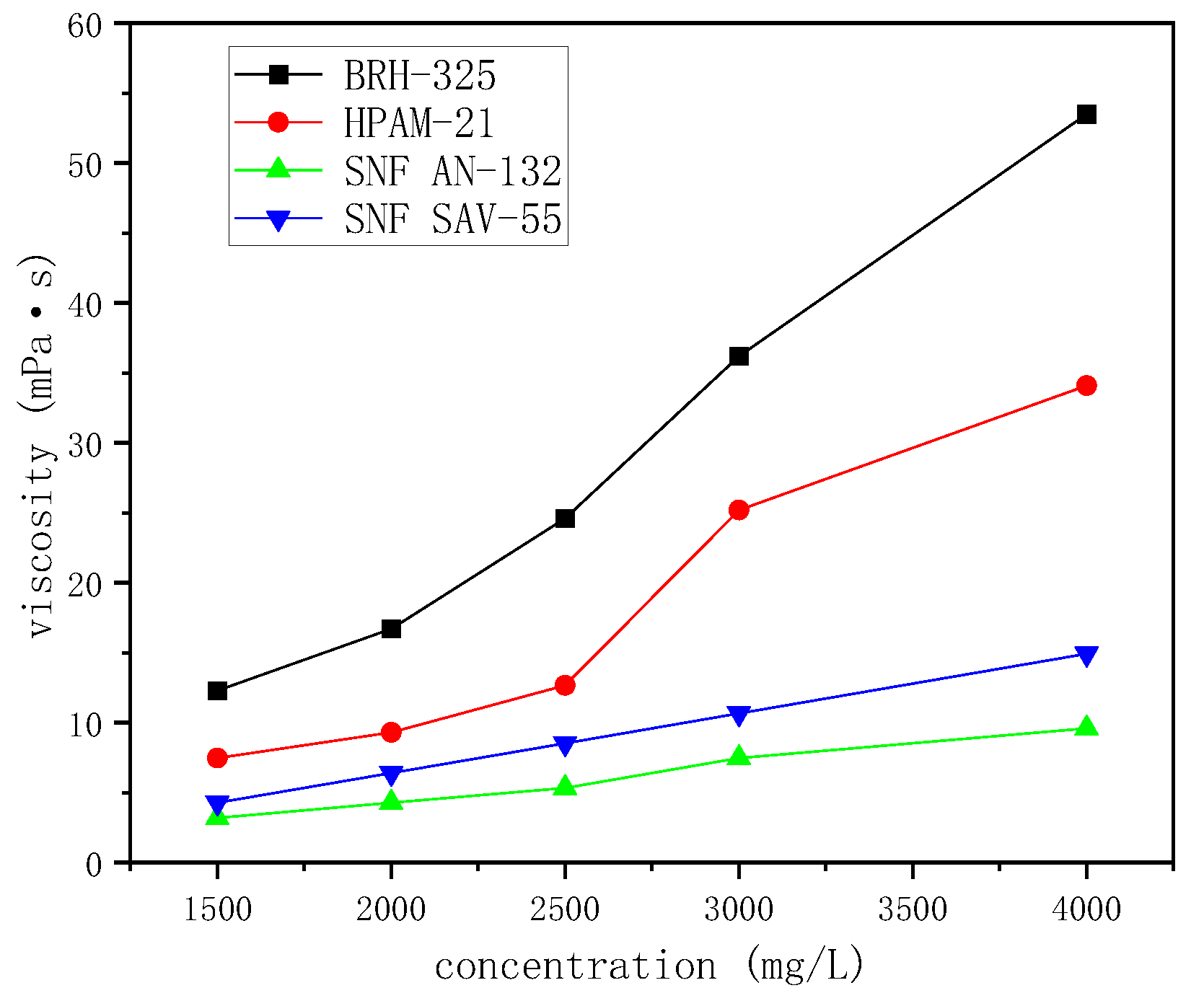
Figure 3.
Variation of interfacial tension with temperature for different surfactant systems.

Figure 4.
Interfacial tension activity of different surfactants.
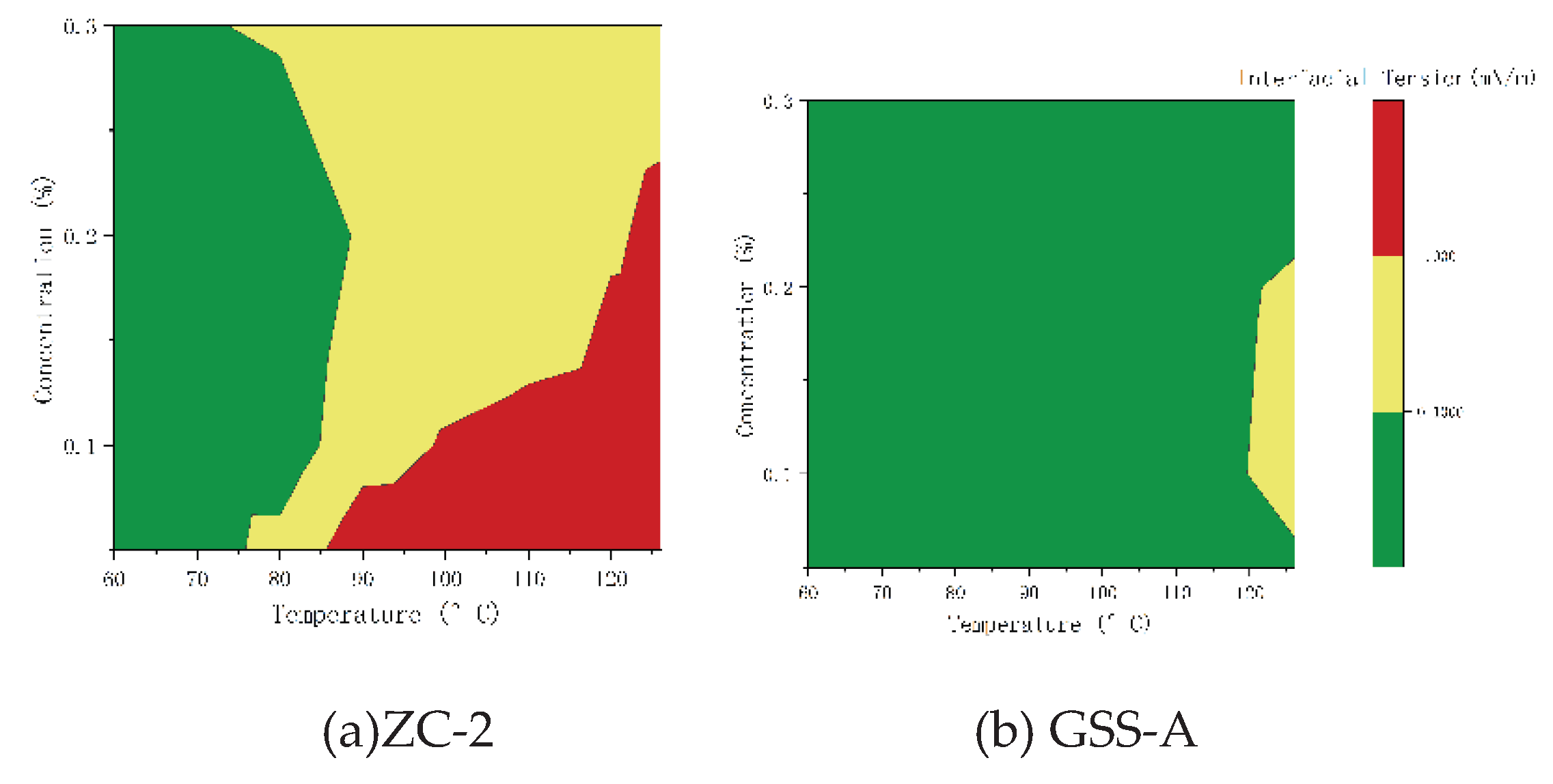
Figure 5.
Variation of oil separation rate of surfactants with time.
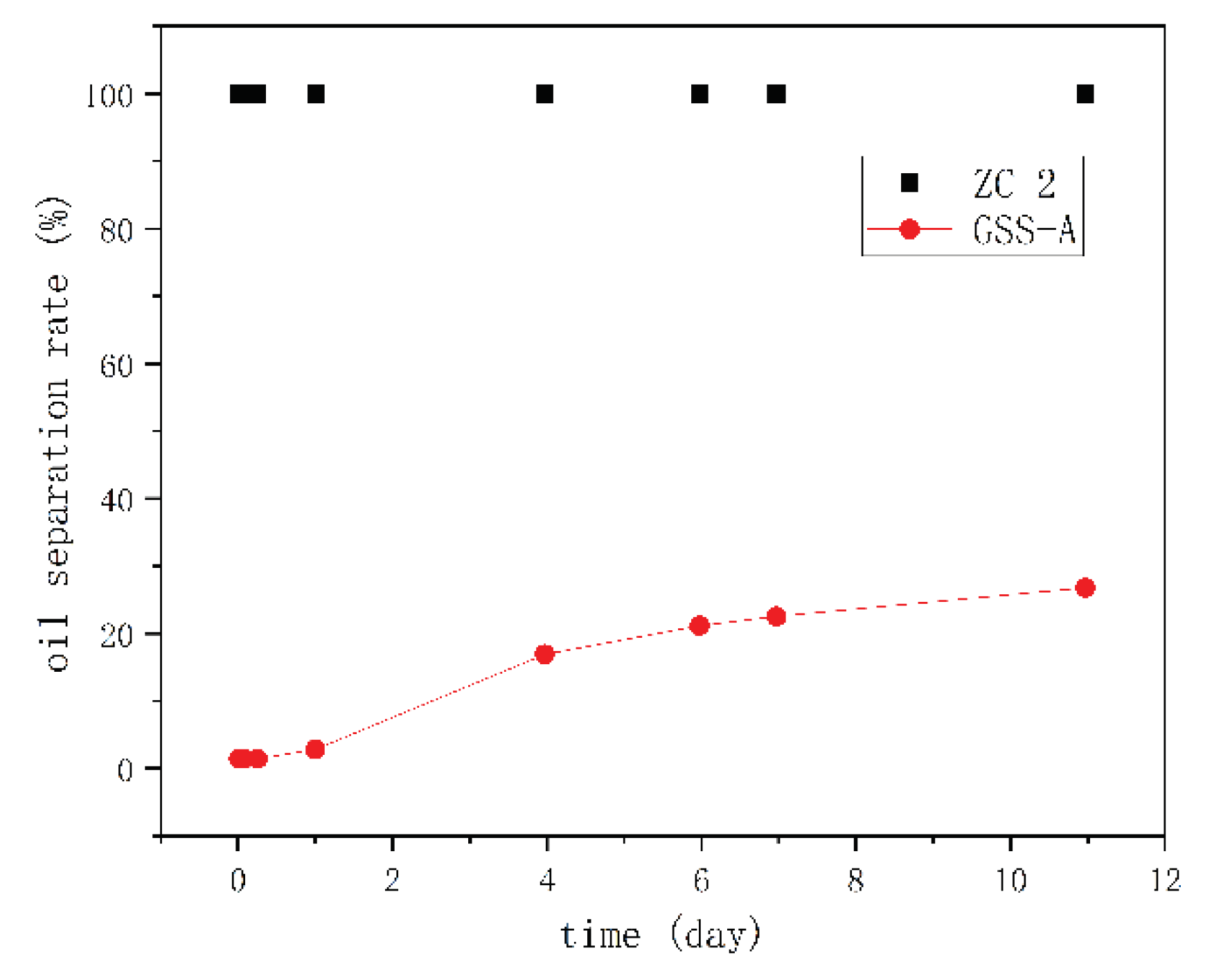
Figure 6.
Variation of oil separation rate of surfactants with concentration.
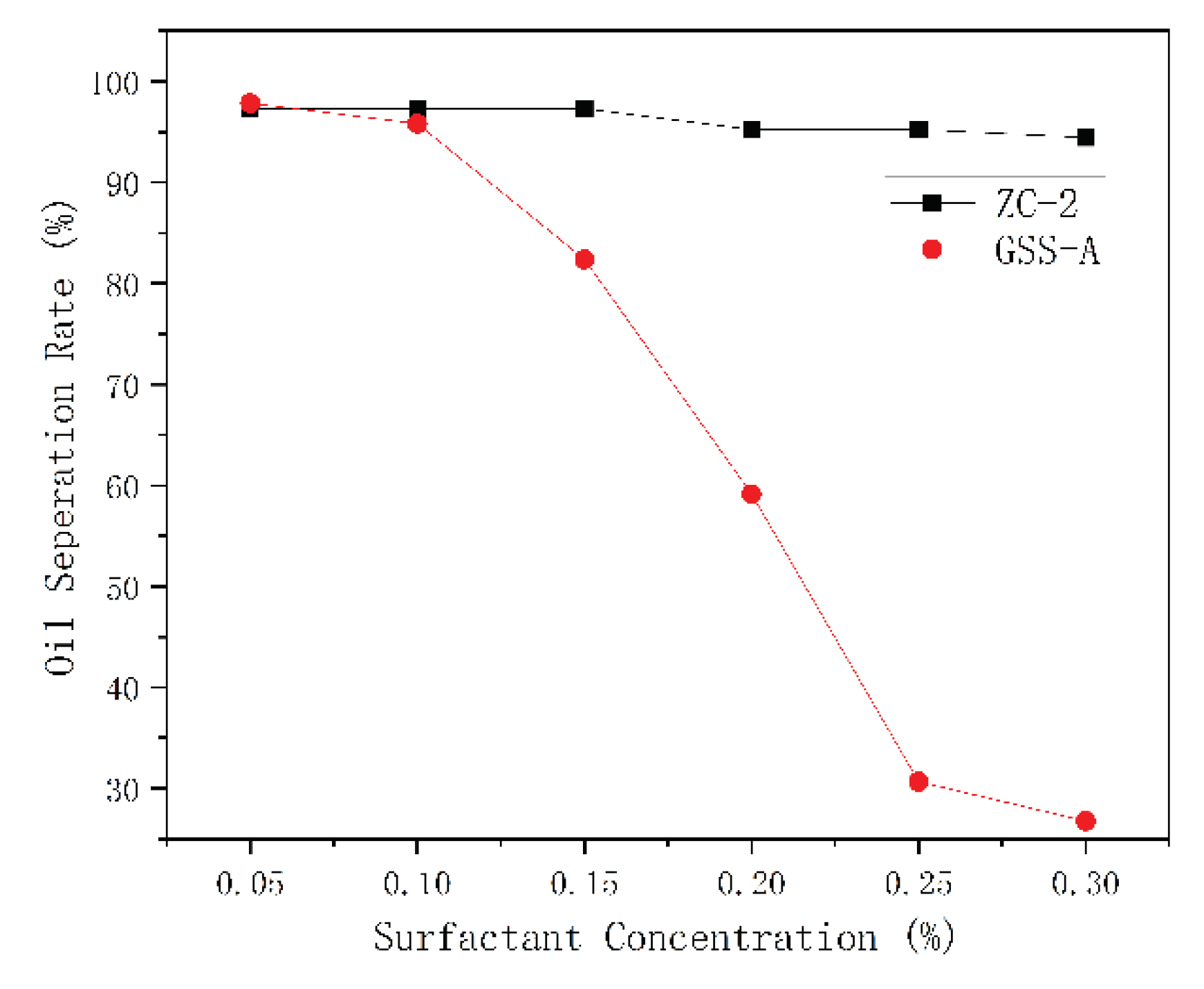
Figure 7.
Variation of oil separation rate of surfactants with salinity.
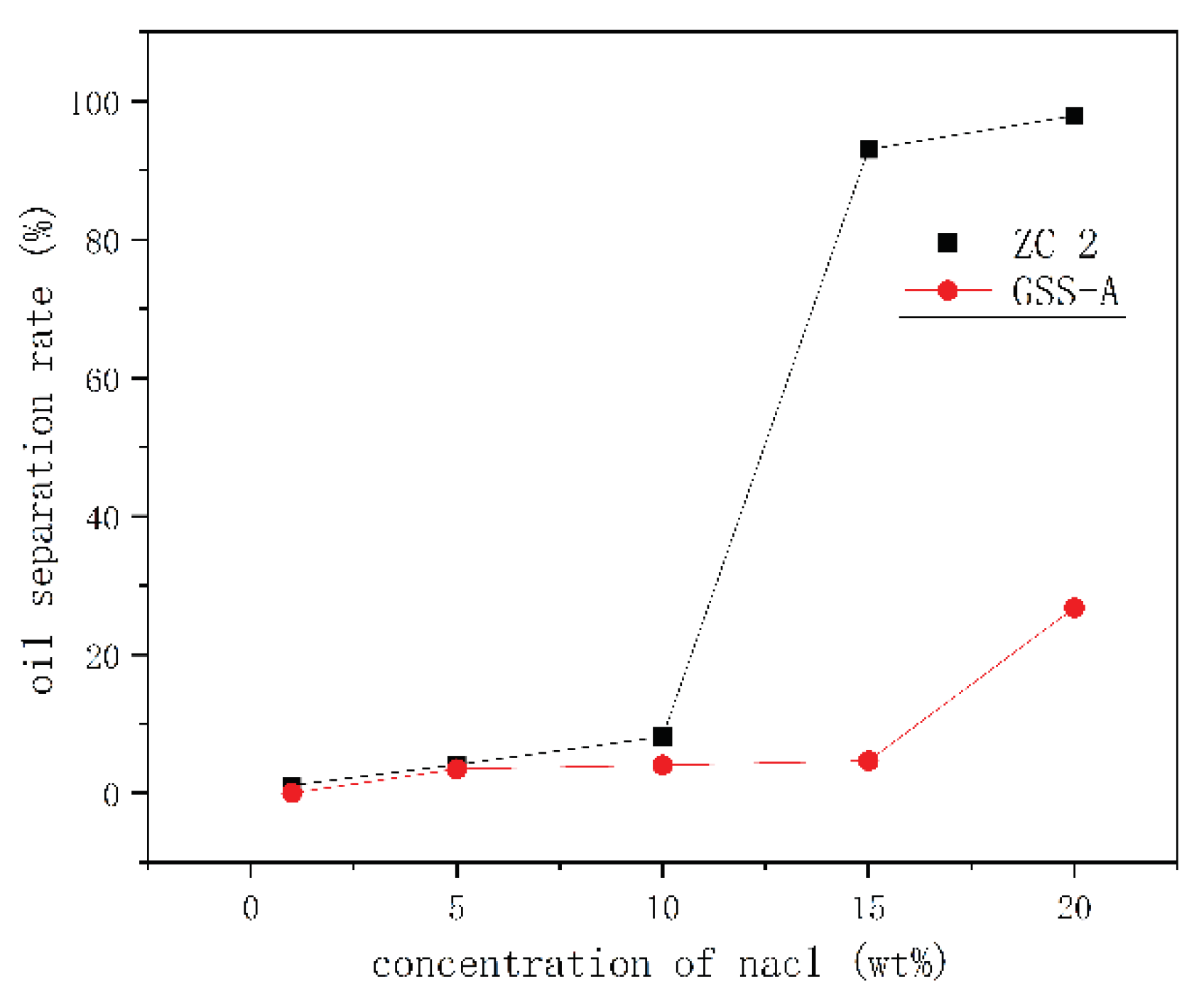
Figure 8.
Interfacial tension of surfactant and SP formula.
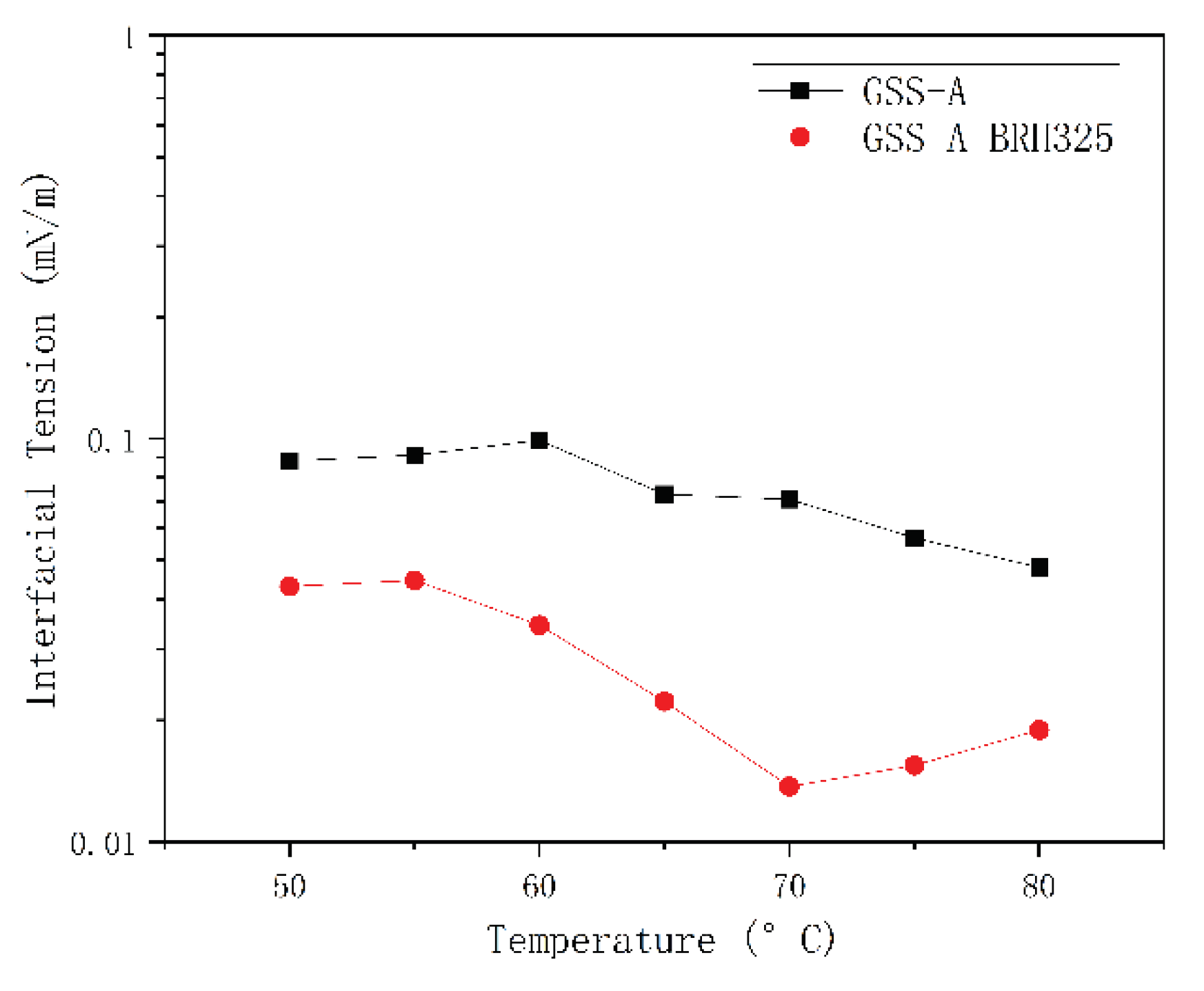
Figure 9.
Viscosity of polymer and SP formula.
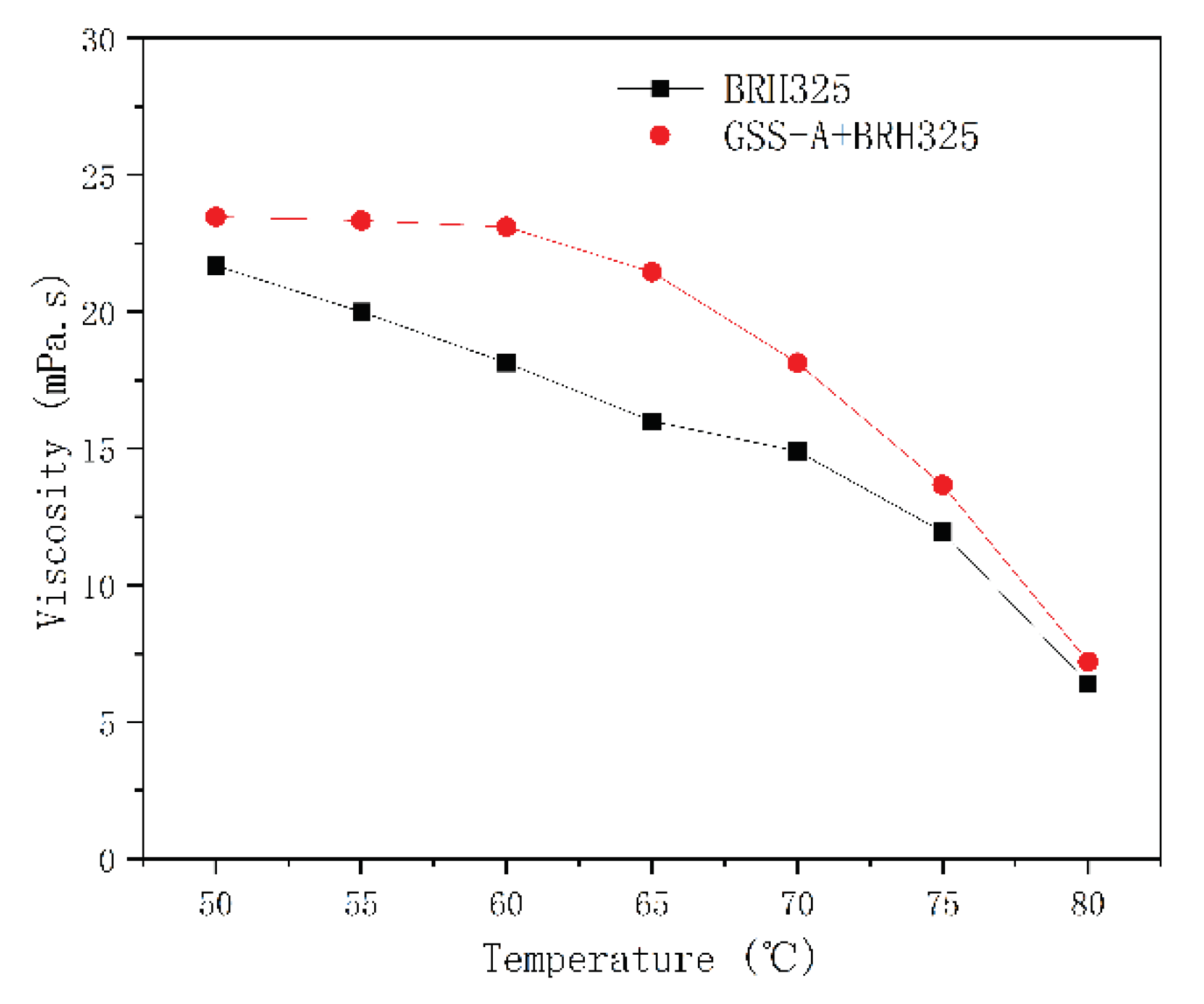
Figure 10.
Core flooding result of surfactant flooding.
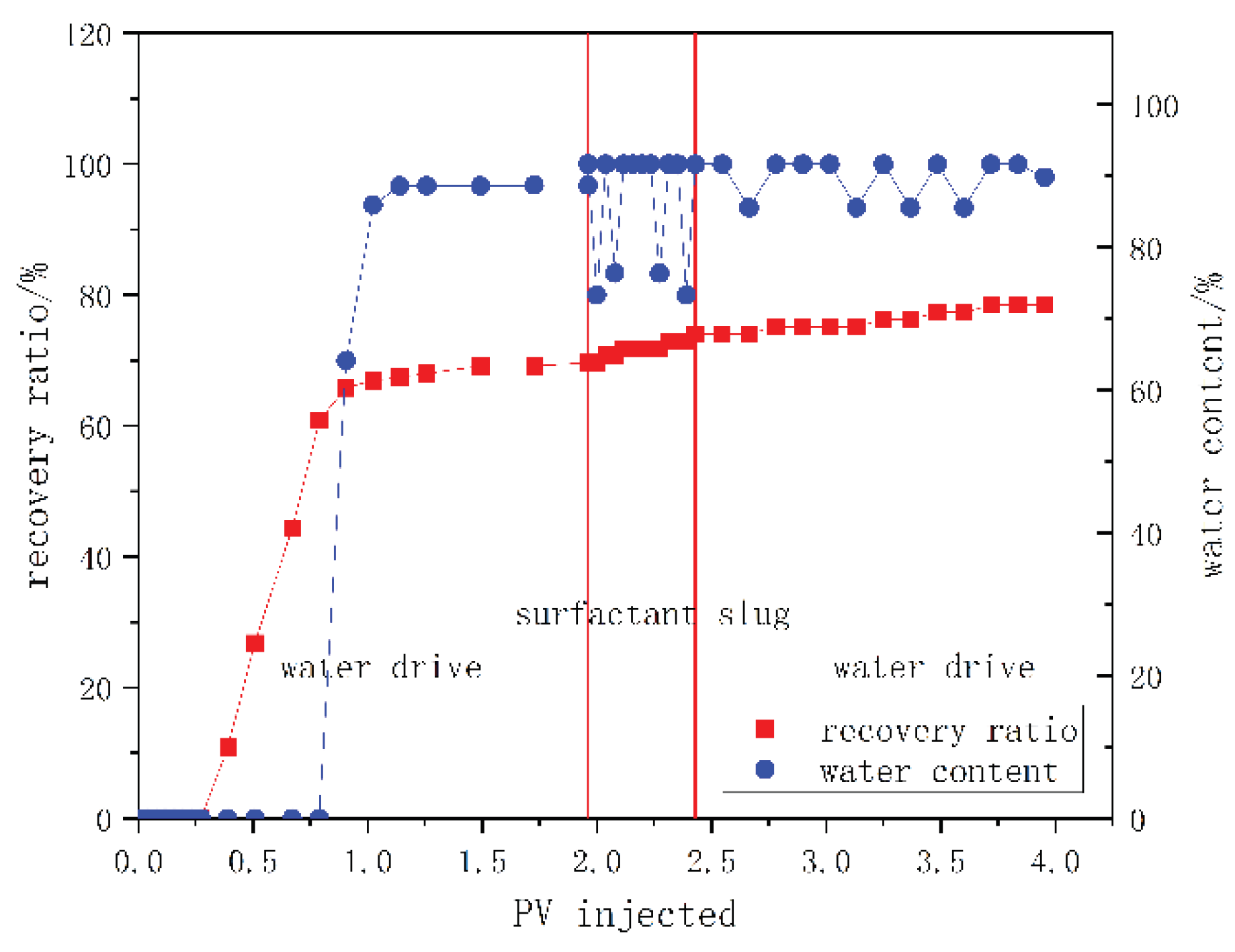
Figure 11.
Core flooding result of SP flooding.
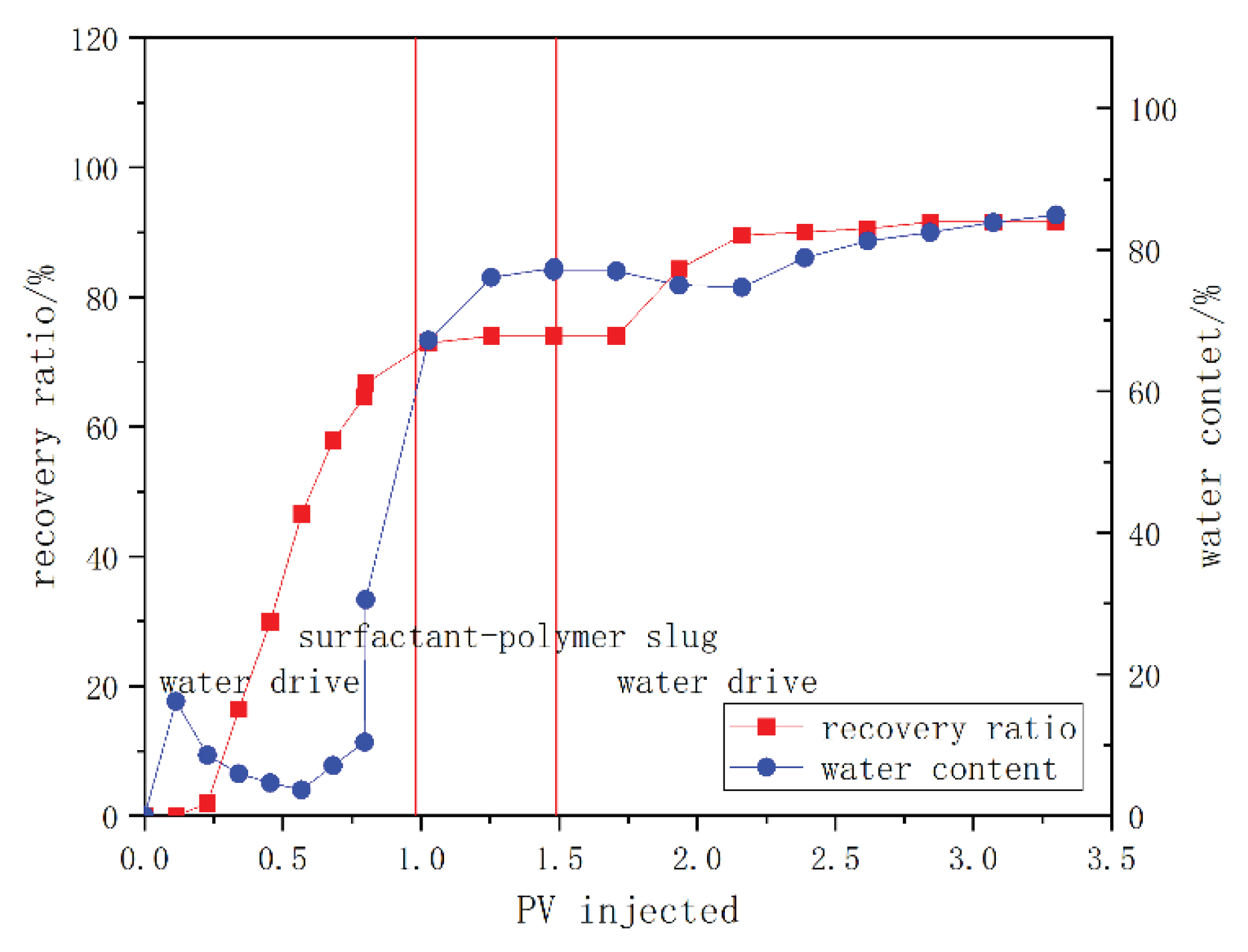
Disclaimer/Publisher’s Note: The statements, opinions and data contained in all publications are solely those of the individual author(s) and contributor(s) and not of MDPI and/or the editor(s). MDPI and/or the editor(s) disclaim responsibility for any injury to people or property resulting from any ideas, methods, instructions or products referred to in the content. |
© 2024 by the authors. Licensee MDPI, Basel, Switzerland. This article is an open access article distributed under the terms and conditions of the Creative Commons Attribution (CC BY) license (http://creativecommons.org/licenses/by/4.0/).
Copyright: This open access article is published under a Creative Commons CC BY 4.0 license, which permit the free download, distribution, and reuse, provided that the author and preprint are cited in any reuse.
MDPI Initiatives
Important Links
© 2024 MDPI (Basel, Switzerland) unless otherwise stated






